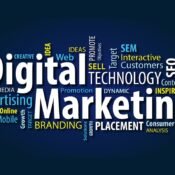
A Comprehensive Guide to Digital Marketing: Trends, Strategies, and Best Practices
In the ever-evolving world of business, digital marketing has become an essential strategy for companies aiming to increase their online presence, engage with customers, and drive sales. With the constant rise of digital technology and online consumer behaviors, businesses must adapt to the digital landscape to stay competitive. This article delves into the key strategies, trends, and best practices in digital marketing that can help businesses achieve long-term growth and success.
What is Digital Marketing?
Digital marketing refers to the use of digital channels, platforms, and technologies to promote and advertise products or services to consumers. It includes various forms of marketing such as social media marketing, search engine optimization (SEO), email marketing, content marketing, affiliate marketing, and pay-per-click (PPC) advertising.
Digital marketing offers businesses an opportunity to reach a global audience, interact with potential customers in real-time, and measure marketing success through data analytics. Unlike traditional marketing methods, digital marketing is highly cost-effective, targeted, and measurable, making it a crucial part of any modern marketing strategy.
Key Digital Marketing Strategies
Digital marketing is a vast field, but the following strategies are considered the core pillars of a comprehensive digital marketing plan:
1. Search Engine Optimization (SEO)
SEO is the process of optimizing a website to rank higher on search engine results pages (SERPs), making it easier for users to find relevant content when searching for keywords related to your business. Effective SEO strategies include optimizing website content, improving site speed, using relevant keywords, and acquiring high-quality backlinks.
SEO Best Practices:
- Keyword research: Identify high-traffic, low-competition keywords and use them strategically in your content.
- On-page SEO: Focus on optimizing page titles, meta descriptions, headings, and URL structures.
- Technical SEO: Improve site speed, mobile-friendliness, and site security (HTTPS).
- Content optimization: Create high-quality, informative, and engaging content that answers users’ queries.
- Link building: Build authoritative backlinks to increase your site’s credibility and domain authority.
By focusing on these SEO strategies, businesses can increase organic traffic and improve their chances of being discovered by potential customers.
2. Content Marketing
Content is at the heart of any successful digital marketing campaign. Content marketing involves creating valuable, relevant, and consistent content to attract and retain a target audience. The ultimate goal is to drive profitable customer action, such as making a purchase, subscribing to a newsletter, or engaging with your brand on social media.
Content Marketing Best Practices:
- Blogging: Start a blog that addresses common customer questions, solves problems, or offers insights into industry trends.
- Video Marketing: Create engaging videos that showcase your products, services, or share educational content.
- Infographics: Use visual storytelling to explain complex information or present data in an easy-to-understand format.
- E-books and Whitepapers: Offer in-depth resources on specific topics to build trust and establish your authority in your industry.
Great content helps businesses build brand awareness, establish thought leadership, and foster deeper customer relationships.
3. Social Media Marketing
Social media marketing involves using platforms like Facebook, Instagram, Twitter, LinkedIn, and TikTok to promote your brand, interact with customers, and drive traffic to your website. Social media provides businesses with the opportunity to directly engage with their target audience, build brand loyalty, and increase awareness.
Social Media Best Practices:
- Know your audience: Tailor content to the platform and audience demographics (e.g., Instagram for younger users, LinkedIn for B2B).
- Consistency: Post regularly to maintain visibility and engagement.
- Engage with followers: Respond to comments, messages, and reviews to show your brand is approachable.
- Paid advertising: Utilize social media ads to target specific demographics and expand your reach.
Social media marketing is a powerful tool to engage with existing customers and attract new ones by showcasing your brand's personality and values.
4. Email Marketing
Despite being one of the oldest forms of digital marketing, email marketing remains one of the most effective ways to nurture relationships with customers, build brand loyalty, and drive conversions. With personalized and segmented email campaigns, businesses can send targeted messages to specific segments of their audience based on interests, behaviors, or demographics.
Email Marketing Best Practices:
- Personalization: Use customer names and tailor content based on their behavior or purchase history.
- Segmentation: Segment your email list based on demographics, interests, or customer lifecycle stage to send relevant content.
- Compelling subject lines: Write engaging subject lines to increase open rates.
- Clear call-to-action (CTA): Include a clear, easy-to-find CTA that encourages readers to take action.
Email marketing helps businesses stay top-of-mind and can lead to high ROI when executed properly.
5. Pay-Per-Click (PPC) Advertising
PPC is a form of digital advertising where businesses pay for each click on their ads. This model is used in platforms like Google Ads and Bing Ads, as well as on social media platforms like Facebook and LinkedIn. PPC advertising provides immediate visibility and can be highly targeted to reach specific audience segments.
PPC Best Practices:
- Keyword targeting: Choose keywords that align with your audience's search intent and create ads that provide a clear solution.
- Optimize landing pages: Ensure the landing page corresponds to the ad’s promise and provides a smooth user experience.
- A/B testing: Test different ad copies, visuals, and CTAs to optimize performance.
- Budget management: Monitor and adjust your budget based on the performance of your ads to maximize ROI.
PPC advertising can be an effective way to gain visibility and drive targeted traffic quickly, but it requires careful budget management and optimization.
Emerging Trends in Digital Marketing
The digital marketing landscape is continuously evolving, and staying on top of emerging trends can help businesses maintain a competitive edge. Here are a few key trends to watch in 2024:
1. Artificial Intelligence (AI) and Machine Learning
AI and machine learning are transforming digital marketing by providing insights into consumer behavior, personalizing customer experiences, and automating tasks. For instance, AI-powered chatbots can provide real-time customer support, while machine learning algorithms can improve ad targeting and content recommendations.
2. Voice Search Optimization
With the rise of smart speakers and voice assistants like Alexa, Siri, and Google Assistant, optimizing for voice search has become crucial for businesses. Voice search queries are often longer and more conversational, so adjusting your SEO strategy to include natural language keywords is essential.
3. Video Marketing
Video continues to dominate as one of the most effective content types for engagement. Whether it’s live-streaming on platforms like Instagram or Facebook, YouTube videos, or short-form videos on TikTok, video marketing can help brands connect with their audiences on a more personal level.
4. Influencer Marketing
Partnering with influencers can help brands tap into niche audiences and build trust quickly. Influencers already have established credibility and a loyal following, making them ideal for promoting products or services in an authentic way.
5. Augmented Reality (AR) and Virtual Reality (VR)
AR and VR are reshaping how customers interact with brands. For example, businesses in the retail sector are using AR to allow customers to virtually try on products, while VR is being used for immersive experiences in industries like real estate and travel.
The Importance of Analytics in Digital Marketing
One of the biggest advantages of digital marketing is the ability to measure the success of campaigns. Tools like Google Analytics, social media insights, and email campaign metrics provide valuable data on user behavior, traffic sources, conversion rates, and ROI. By analyzing this data, businesses can identify what’s working, what’s not, and adjust their strategies accordingly.
Common Challenges in Digital Marketing
While digital marketing offers numerous opportunities, businesses often face several challenges, such as:
- Keeping up with technological changes: The digital landscape is always evolving, and staying updated on new tools, platforms, and trends is crucial.
- Intense competition: With the rise of digital marketing, almost every business is online, making it harder to stand out in a crowded market.
- Data privacy regulations: Laws like GDPR and CCPA require businesses to be transparent about data collection and usage, which can be complex to navigate.
Recent Posts
Get Free Offer
+44 74 4811 5697



